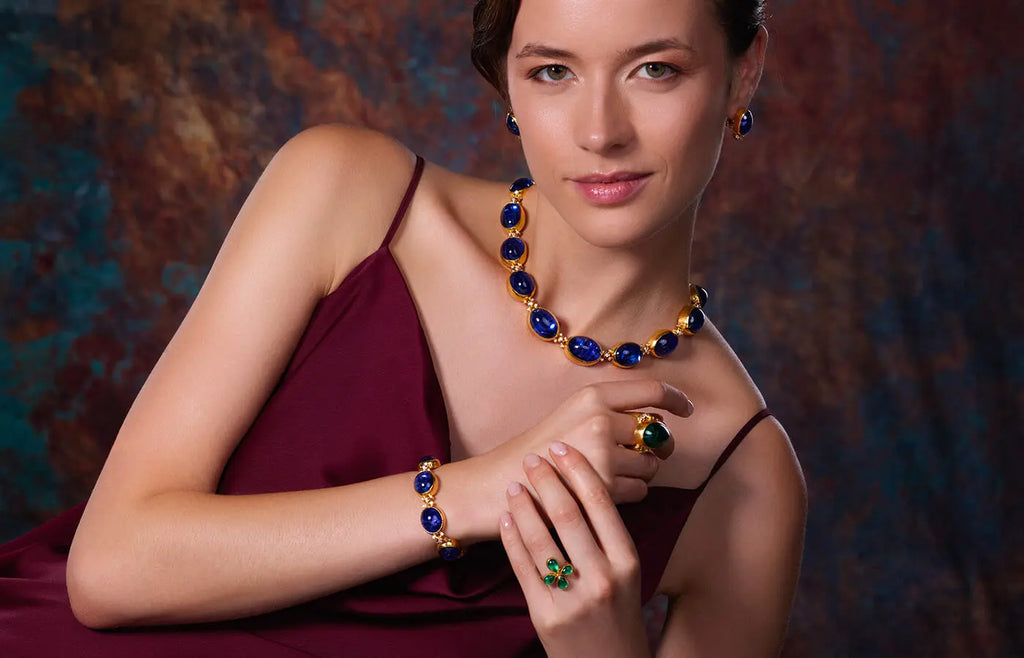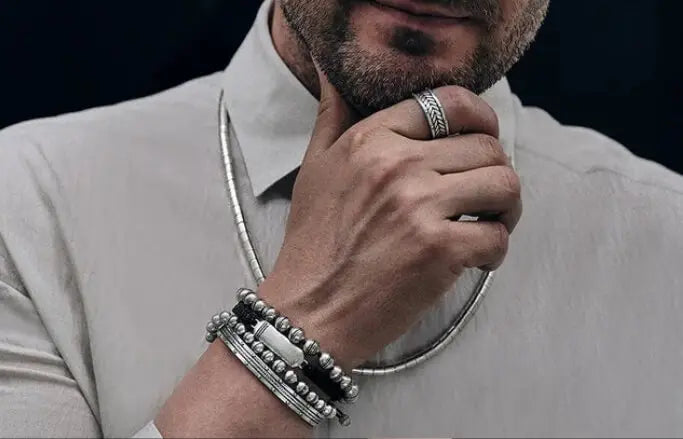The reincarnation of an ancient heritage
Pure 24 karat gold jewelry was so important historically: why don’t more designers create in it today?
Pure 24k gold jewelry is the jewelry of history
 24 karat gold jewelry is one of the most enduring art forms of ancient times. To this day, 24 karat gold jewelry fills the cases of museums all around the world. And historically, jewelry made from 24k gold was the most revered and most precious of adornments. It was sought after by kings and queens, priests and pagans, and aristocrats and plunderers alike. There was a time when anything less than pure gold was considered out of the question.
24 karat gold jewelry is one of the most enduring art forms of ancient times. To this day, 24 karat gold jewelry fills the cases of museums all around the world. And historically, jewelry made from 24k gold was the most revered and most precious of adornments. It was sought after by kings and queens, priests and pagans, and aristocrats and plunderers alike. There was a time when anything less than pure gold was considered out of the question.
So, what happened? Why do so few jewelry designers work in this true gold today? And who is out there today who continues the tradition of making 24k pure gold jewelry?
The History of Pure Gold Jewelry
Past civilizations were drawn to pure gold for its color, luster, malleability and permanence. 24k gold neither corrodes nor tarnishes, making it perfect for crafting into jewelry or other objects of luxury. Gold is also an immensely flexible, durable metal that lasts forever and was easily melted down and re-forged - an early example for recycling!
Gold was first used in jewelry as far back as 4000 B.C. originating most likely in the middle eastern area which today is Iraq and what we now know as the ‘cradle of civilization’.
Famous Historical Examples of 24 karat gold Jewelry
 Dating back to the 3rd millennium BC, the earliest examples of gold jewelry are those found in Queen Pu-abi’s tomb at Ur in Sumer. The queen’s body was covered with a robe of gold and precious stones and on her head were three golden diadems, fastened to a wide gold band. She wore many rings and there were other jewels belonging to the handmaidens, dignitaries, and even the horses that formed part of the funeral train.
Dating back to the 3rd millennium BC, the earliest examples of gold jewelry are those found in Queen Pu-abi’s tomb at Ur in Sumer. The queen’s body was covered with a robe of gold and precious stones and on her head were three golden diadems, fastened to a wide gold band. She wore many rings and there were other jewels belonging to the handmaidens, dignitaries, and even the horses that formed part of the funeral train.
‘Diluting’ pure gold by Alloying it
But for all its beauty and benefits, gold was scarce, expensive, heavy and soft, so when our ancestors learned to mix in other lighter and less precious metals such as silver and copper, they realized that they could make “gold” cheaper, harder and less heavy by alloying it but still calling it “gold”. From that time forward the usage of gold in its pure form diminished.
The ancient Egyptians began experimenting with alloying gold by using a combination of 50 per cent gold and 50 per cent silver in some artefacts and 18K yellow gold has been evident since King Tutankhamen’s era in 1300 BC Egypt. Since then, only a few cultures have maintained a tradition of working in pure gold.
Some Cultures still use Pure Gold for jewelry
24 karat gold jewelry is still made and used prolifically in India, China and the Middle East. In these cultures, it is as much for investment as for adornment, and the demand is mostly culturally driven. A man often gives gold jewelry as a tradition related to marriage. And a woman wears her gold jewelry as a sign of her wealth and social stature. In these countries, jewelry below a 22k would be considered “low quality” and people would not attribute value to it.
But if jewelry sold in these countries is regarded as a commodity in terms of investment value, it is also somewhat of a commodity in terms of design, with very little creativity and imagination going into new or different styles. The jewelry also tends be more ethnic than fashionable in terms of western tastes.
Why 24 karat Gold declined in Popularity in the West
As it became less common to use 24k gold for jewelry in the west, it became less familiar and gained a reputation for being “unsuitable” for jewelry. Indeed, during most of the 20th century pure 24k gold was generally not preferred for jewelry in the U.S. due in large part to a lack of knowledge, a lack of familiarity and a lack of available options.
There are a few reasons why some people in the U.S. and western world used to believe that pure gold was not ideal for jewelry -
- it was perceived as too ‘soft’ or not strong enough for jewelry, making it easily scratched, dented or bent
- the rich gold color was unfamiliar compared to the more diluted, paler colors of gold that resulted from mixing it with white metals
- the cost of the metal reflected its precious value and many people couldn’t or didn’t want to pay that premium pricing
Why 24 karat Gold has now risen in Popularity in the West

FIRSTLY, the myths were set aside:
Too soft? Not if the right techniques are used! Designers like Gurhan Orhan resurrected the techniques of the ancient goldsmiths and were able to create pure gold jewelry by hand that was strong enough for jewelry and which did not possess the rumored fragility. They showed that while it was malleable, it was not “too soft”. In fact, the malleability made it able to be hammered or pressed into shape without breaking or cracking, making it perfect for jewelry!
Too yellow? Says who?! Let’s face it, color is a matter of taste, not a rule. By the late 1990s, the tastes of the American consumer had become much more open to new ideas and the traditional view of what jewelry should look like was being challenged. Designers across the country started experimenting with different shapes, stones and colors of metal. Some designers even mixed metals, breaking another long-held taboo. By the early 2000s, the true yellow color of gold had surged in popularity and now holds equal footing with all other colors of metal for the American consumer.
Too expensive? Or value for money? The intrinsic value of pure gold is much higher than for lower karats of gold that have had the value diluted by the addition of much cheaper metals. But yes, 24k gold is more expensive than jewelry made with lower karat gold. And designer 24k gold jewelry is more expensive than the commoditized products available in India, China or the Middle Eastern that lack any real design value. But if you value precious materials and value true artistry and design, then today’s designer 24k gold jewelry is not less of a value proposition than the cheaper, lower karat options offered in the U.S. market.
NEXT, to truly re-establish itself as a jewelry staple for today’s modern woman, 24k jewelry had to rise to the challenge of being fashionable, wearable and desirable. And this has happened successfully since the late 1990s in the U.S. and spread around the western world ever since. Leading retailers such as Neiman Marcus, Saks Fifth Avenue and Barneys, together with top local jewelry stores around the world have come to recognize that the special value of pure gold deserves a place in every showcase. The stylists, influencers and press have similarly showcased pure gold jewelry as a significant category of jewelry that having been revived, now has a permanent place in jewelry today as well as in history.
Lastly, Celebrities, fashionistas and women of taste and style worldwide now embrace pure gold as an essential part of every fine jewelry wardrobe.
Who designs jewelry in 24k gold today?
The pioneer of designer jewelry made in pure gold in the world today is Gurhan Orhan who sells under his brand, GURHAN. In the early 1990s Gurhan rebelled against the prejudices towards pure gold and made it his mission to reincarnate the techniques of the ancient goldsmiths and create jewelry designs in the pure metal. His maverick ways and exciting designs ignited customers’ enthusiasm and he was quickly successful in the U.S. and European jewelry worlds. It is with pride that he now sees others following in his footsteps. Today there are several other designers who have taken the brave step and created pure gold jewelry brands. They include a number of designers who have established respectable brands in the U.S. Additionally, in his homeland of Turkey, Gurhan is flattered to see that a plethora of jewelers in Istanbul’s Grand Bazaar are “inspired” by his vision and have adopted his signature style in their designs for the tourist market. While there will never be another Gurhan, at least there is a movement of jewelers who have revived the almost-lost art of 24k jewelry design in the western world.
From Sumerian royalty to Hollywood royalty, pure 24 karat gold jewelry reigns today!





